Web Enabling Your Applications
VERSION 1.0: MARCH, 1996
March 1996
Author: Helen Barnes
Contributors: Mike Gwyer
Copyright © 1996 Oracle Corporation.
All rights reserved. Printed in the U.S.A.
This document is provided for informational purposes only and the information herein is subject to change without notice. Please report any errors herein to Oracle Corporation. Oracle Corporation does not provide any warrants covering and specifically disclaims any liability in connection with this document.
Table of Contents
INTRODUCTION
Oracle
WebServer Overview
Designer/2000
WebServer Generator
Designer/2000
Repository
REVERSE
ENGINEERING AND GENERATION FOR THE WEB
1 Reverse
engineering database tables
2 Reverse
engineering your application
3 Generate
for the Web
THE
GENERATED WEB APPLICATION
CONCLUSION
Recommended Reading:
Oracle Designer/2000 WebServer
Generator Technical Overview,
Version 1, February 1996, Mike Gwyer
Introduction
The World Wide Web provides an environment for distributing applications to
many users. By creating Hyper-Text Markup Language (HTML) documents and publishing the Universal Resource Locator (URL), documents are visible to anyone with an industry standard Web Browser.
Maintenance of software on a large number of PC clients has become an increasingly time-consuming task for software librarians, DBAs and systems managers. Using the World Wide Web, a Web page for an application can be used by as many users as required, with the code stored once on the server. Installation and maintenance issues are no longer a major concern.
The only software required on the client is the Web browser, such as Oracle Power Browser, or Netscape. The Browser presents Web pages to the user, and the user has control over a number of variables related to the appearance of the data eg font size and colour, background colour. Browsers are currently much cheaper and easier to deploy than an equivalent client-server application deployment tool.
Oracle products now allow us to supplement static HTML with dynamic access to the database. By providing pages built in real time from the database, Web applications move from a static to a dynamic environment, greatly increasing their value for the Web user.
This document describes the process of reverse engineering, via Designer/2000, an existing application deployed in Developer/2000. The application is then generated for the Web, using the Designer/2000 WebServer generator. The investment in producing the original application is not lost, as the reverse engineering process captures information about data accessed form the database and stores it in the repository, ready for generation into another deployment environment.
This also means that applications can be deployed over heterogeneous environments with no rework, eg deployed in Developer/2000, Visual Basic, Oracle Power Objects and the Web.
Oracle WebServer Overview
The Oracle WebServer is integrated with the Oracle7 database. Business data stored on the Oracle7 database is dynamically formatted into Web (HTML) documents within the WebServer and then transmitted to Web Clients, on demand from the user.
Figure : Oracle WebServer presents HTML pages and dynamic data to Web Browsers
Web users request information by entering an appropriate Uniform Resource Locator (URL). The URL specifies the target Oracle WebServer machine or site, the WebServer session (Oracle database logon information) and the PL/SQL routine which will run.
Designer/2000 WebServer Generator
The Oracle Designer/2000 WebServer Generator provides the benefits of modelling and team-working to sites who want to deploy applications on the Web. The WebServer Generator uses the same modelling techniques as the other Designer/2000 generators (ie Developer/2000 and Visual Basic). Thus it offers the ability to generate and deploy Web applications from definitions already built and deployed in Developer/2000 or Visual Basic.
Using Designer/2000 we can present not only static Web pages, but interactive
query pages, where users can enter query parameters and use these to query a
database. The query runs against a live, on-line database, resulting in a response
which provides up-to-date data for the user.
Consequently, we can present the user with an application which provides the
same data as a traditional client-server application, through a convenient and
cheap interface, with a very low deployment and maintenance overhead.
Designer/2000 Repository
Figure : Oracle Designer/2000
Designer/2000 uses a repository to store design information including data models, modules, module structure, module logic and preferences (style guide). From information in the repository, we can generate database definition language, which can be run to create tables, columns, constraints and other database objects. We can also generate program definitions into Web pages, as well as Developer/2000 and Visual Basic.
Designer/2000 also has a reverse engineering utility, which will read definitions of Oracle7 objects including tables, views, constraints, indexes etc in an existing database and write them to the repository. Reverse engineering of Developer/2000 Forms allows table and column usages for those forms to be stored in the repository.
Using this information we can generate the same application (or a modified, re-engineered or new one) against the same database schema, giving users a new
interface (eg the Web) to their data.
Reverse Engineering and Generation for the Web
This section describes the process of reverse engineering an Oracle application in Developer/2000 (Forms 4.5) into the Designer/2000 repository, and generating the same application for the World Wide Web.
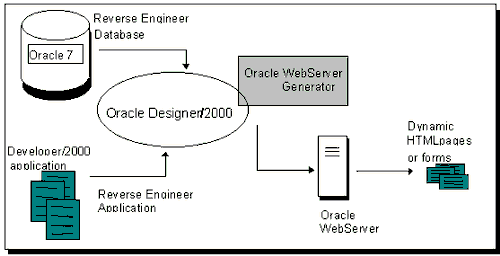
Figure : The process of reverse engineering and generating, based around the repository
There are three main steps in the process:
1 Reverse engineering database tables
2 Reverse engineering your application
3 Generate for the Web
In the following example, we reverse engineer the module funds, which shows details of funds, fund sectors and fund holdings. The form is based on three tables called FUNDS, FUND_SECTORS and FUND_HOLDINGS. The `Reverse Engineer Database' utility recovers the data schema including these tables and updates the Designer/2000 repository. An application has already been created using Developer/2000, and the module for funds relates the units together as master-detail-detail. The module definition is created in the repository by the `Reverse Engineer Forms' utility.
Finally, the WebServer generator is run to generate a Web application from the repository definition of the FUNDS module, using the preferences for appearance of Web applications also stored in the Repository.
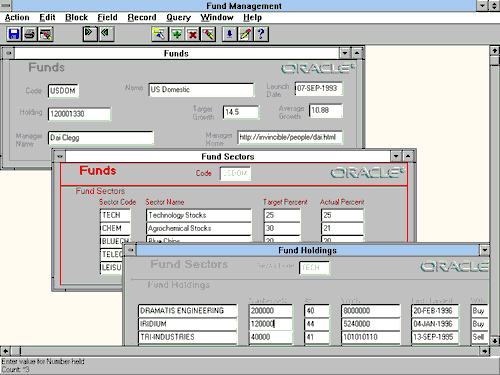
Figure : Funds application deployed in Developer/2000 Forms, with windows for funds, fund sectors and fund-holdings
1 Reverse engineering database tables
The `Reverse Engineer Database' utility puts the table definitions into the repository, along with definitions of any other Oracle7 database objects which exist, such as views, constraints, indexes, sequences etc. The server generator then creates the DDL for the objects, which you can execute against any Oracle 7 (or ANSI) database.
Figure : Reverse Engineering the tables FUNDS, FUNDS_SECTORS and FUND_HOLDINGS
2 Reverse engineering your application
Designer/2000 will reverse engineer your Developer/2000 application into the
repository. The `Reverse Engineer Form' utility will create a module definition and store table and column usages for that module in the repository.
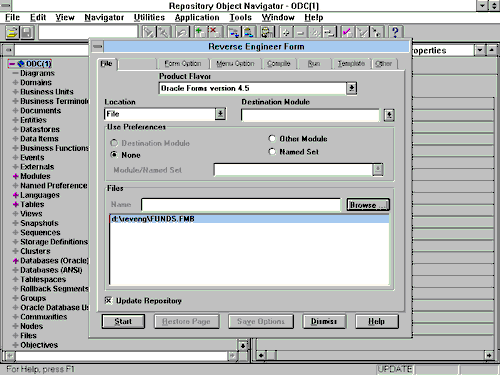
Figure : Reverse engineering the Developer/2000 forms application for FUNDS (funds.fmb)
The utility produces a report to show which tables and column it has found
used in the program.
Using the Module Data Diagrammer, one of the Designer/2000 toolset, we can visually represent the module definition which we now have in the repository.
The diagram appears as below, with the table usages showing a master-detail-detail relationship.
At this stage it is necessary to add display prompts to the table and column definitions or to the module's detailed column usages, as they are not stored in the repository by the reverse engineer forms utility.
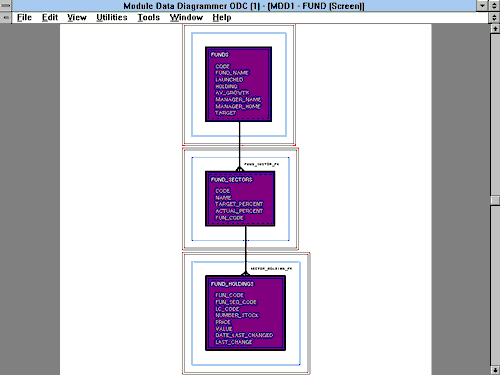
Figure : The Module Data Diagrammer visually represents the module definition of the FUNDS module
Reverse engineering a Developer/2000 report will also result in a module definition in the repository, which can be examined and modified if necessary, then generated into a Web-enabled application.
If you do not have Developer/2000 applications, (Forms or Reports), then a module can be created in the repository, and a module data diagram created by dragging and dropping table definitions onto the drawing surface. The generation process from here is as described below.
3 Generate for the Web
The Designer/2000 web generator generates a web page (or set of pages ) for a
module. During generation the Oracle WebServer Generator creates a set of PL/SQL packages, which are then installed into an Oracle WebServer database.
 Figure : Oracle WebServer
generator produces PL/SQL packages which are used to
create dynamic Web pages
Figure : Oracle WebServer
generator produces PL/SQL packages which are used to
create dynamic Web pages
Oracle PowerBrowser, or any other HTML Browser may be used to run generated applications. Preferences control the appearance of the generated output - for example; justification of number fields, layout of record lists and query pages.
The Generated Web Application
Below is the set of Web pages generated from the Funds module after it was reverse engineered into the repository. The startup page has a query dialogue, in order to refine the data retrieved from the database. If the fields are left blank, all of the rows are retrieved. Subsequent links to detail records are automatically generated, so navigating through the master-detail-detail structure of the module is presented in exactly the same fashion as static Web pages, using HTTP links.
Textual information on the page is generated from module help text stored in the repository. The query fields are based on those fields marked `queryable' in the repository.
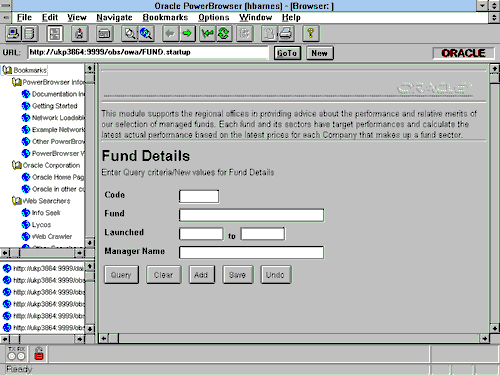
Figure : Startup page for FUNDS Web application showing query fields and text derived from module help
Figure : List of Funds dynamically created
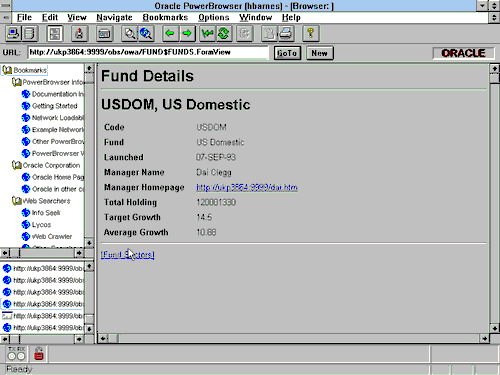
Figure : Generated Web page showing Fund Details and http links - Fund Sectors is a link to another generated page in this module
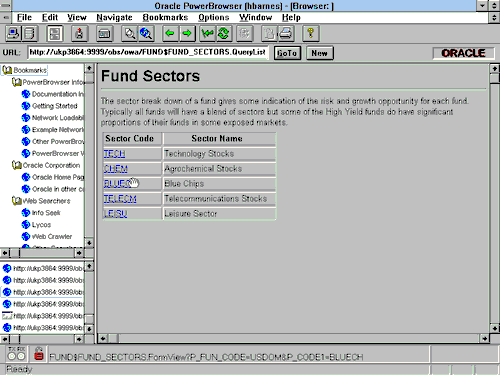
Figure : Generated Web page showing Fund Sectors and http links to further information on generated pages
.
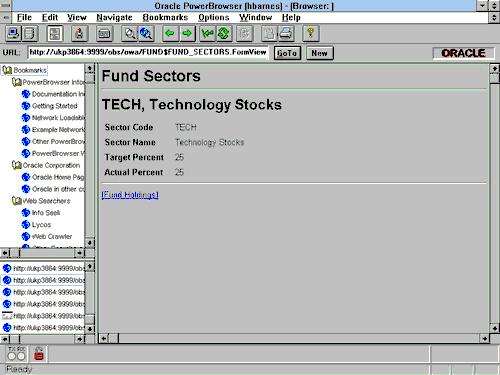
Figure : Fund Sector record details and link to Fund Holdings
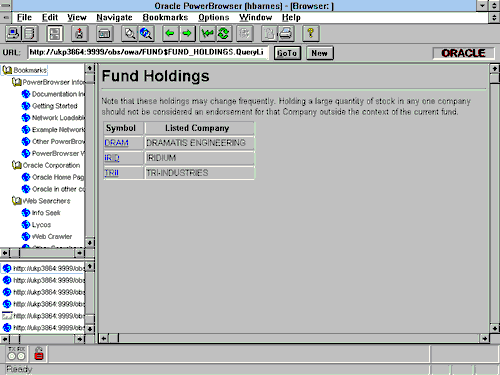
Figure : Fund holdings record list

Figure : Fund Holdings record detail - the final generated page of the funds module
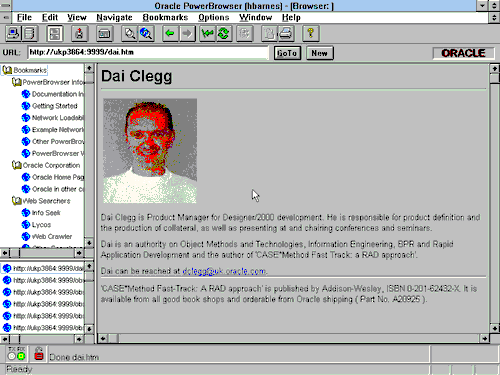
Figure : This static HTML page is linked from the URL in Figure 10
Conclusion
Designer/2000's WebServer generator produces Web applications very quickly and simply from module definitions in the repository. These module definitions may be created against table definitions, or reverse engineered from existing applications.
Reverse Engineering existing applications populates the repository with module definitions from which we can directly generate web applications, obviating the need to create new module definitions. Consequently, the deployment of existing applications to the Web becomes a simple and quick process using the powerful Designer/2000 WebServer Generator.
